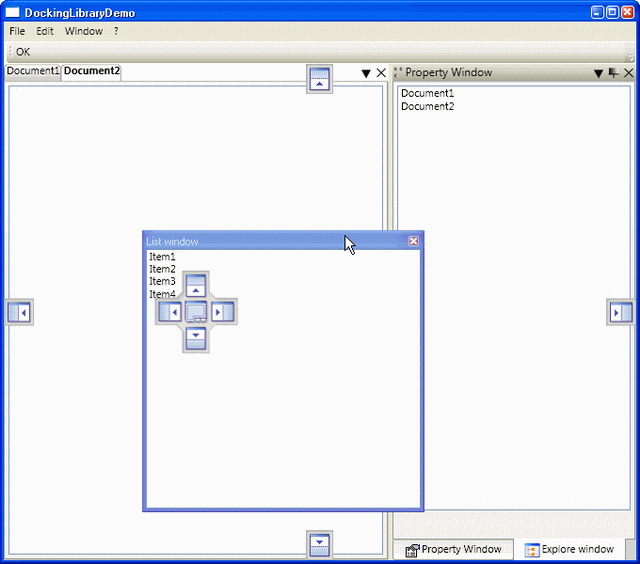
Introduction
Recently, I started a project for porting a Windows Forms application to WPF. I was quite a novice in WPF, so at first I was considering using some type of Windows Forms interoperability. In particular, the WinForm application has cool docking functionalities that I wanted to port to a newer version. As I was going deeper into WPF technology, I discovered a new world that radically changed my initial ideas. In this article, I wish to share a library that implements the Windows docking feature in pure WPF without any Win32-interop.
Using the code
There are three fundamental classes: DockManager, DockableContent and DocumentContent. DockManager is a class responsible for managing the main window layout. Pane represents the window area that can be docked to a border. Each Pane contains one or more ManagedContent elements, which precisely refer to a window content element of the client code. Using this library is straightforward. DockManager is a user control that can be easily embedded into a window. For example, the following XAML code creates a DockManager in a DockPanel:
<Window x:Class="DockingDemo.MainWindow"
xmlns="http://schemas.microsoft.com/winfx/2006/xaml/presentation"
xmlns:x="http://schemas.microsoft.com/winfx/2006/xaml"
Title="DockingDemo" Height="500" Width="500"
xmlns:custom="clr-namespace:DockingLibrary;assembly=DockingLibrary"
Loaded="OnLoaded" Background="LightGray" >
<DockPanel>
<Menu DockPanel.Dock="Top">
<MenuItem Header="File">
<MenuItem Header="New" Click="NewDocument"/>
<MenuItem Header="Exit" Click="ExitApplication"/>
</MenuItem>
<MenuItem Header="Edit"/>
<MenuItem Header="Window">
<MenuItem Header="Explorer" Click="ShowExplorerWindow"/>
<MenuItem Header="Output" Click="ShowOutputWindow"/>
<MenuItem Header="Property" Click="ShowPropertyWindow"/>
<MenuItem Header="ToDoList" Click="ShowListWindow"/>
</MenuItem>
<MenuItem Header="?"/>
</Menu>
<ToolBar DockPanel.Dock="Top">
<Button>OK</Button>
</ToolBar>
<custom:DockManager Name ="DockManager"/>
</DockPanel>
</Window>
Notice that to use DockManager you have to refer an external CLR namespace, DockingLibary here. You can now add your windows to DockManager with code like this:
public partial class MainWindow : System.Windows.Window
{
private TreeViewWindow explorerWindow = new TreeViewWindow();
private OutputWindow outputWindow = new OutputWindow();
private PropertyWindow propertyWindow = new PropertyWindow();
private ListViewWindow listWindow = new ListViewWindow();
public MainWindow()
{
InitializeComponent();
}
private void OnLoaded(object sender, EventArgs e)
{
dockManager.ParentWindow = this;
propertyWindow.DockManager = dockManager;
propertyWindow.Show(Dock.Top);
explorerWindow.DockManager = dockManager;
explorerWindow.Show();
listWindow.DockManager = dockManager;
listWindow.ShowAsDocument();
}
}
Ib order to be dockable, a window must derive from DockableContent. Deriving from DockableContent indicates that the window content can be hosted in DockablePane. Windows are initially docked either where you set the Show member call or, by default, to the left border. The last thing to see is how to add a document window. A document window is a particular window that can't be docked to the main window border. It lives only in DocumentsPane which, as DockablePane, is a particular kind of Pane. The following code adds a document window with a unique title to DockManager:
private bool ContainsDocument(string docTitle)
{
foreach (DockingLibrary.DocumentContent doc in DockManager.Documents)
if (string.CompareOrdinal(doc.Title, docTitle) == 0)
return true;
return false;
}
private void NewDocument(object sender, EventArgs e)
{
string title = "Document";
int i = 1;
while (ContainsDocument(title + i.ToString()))
i++;
DocumentWindow doc = new DocumentWindow();
doc.Title = title+i.ToString();
DockManager.AddDocumentContent(doc);
}
Points of interest
Exactly how is docking realized? I implement a simple algorithm here to manage relations between windows that are docked. DockingGrid contains code to organize Pane in a logical tree. DockManager calls DockingGrid.ArrangeLayout in order to organize the window layout. You also use DockingGrid.ChangeDock when you need to dock a Pane to a main window border. The following image shows a logical tree of panes. Don't get confused with the WPF logical tree.

Each node is a group of either two Panes or a Pane and a child. To arrange the layout, DockingGrid creates a WPF grid for each group with two columns or two rows, depending on split orientation. I hope the image is self-explanatory. Anyway, feel free to ask for more details if you are interested.
From version 0.1, the library supports floating windows, as you can see in VS. A floating window is an instance of the FloatingWindow class. It' s a very particular window because it needs to "float" between two windows. One is the parent window, MainWindow in this case, which is usually the main application window. The other is a transparent window owned by FloatingWindow itself, which is shown during dragging operations.

As you can see in the previous image, FloatingWindow supports useful switching options through a context menu on the title bar. In WinForms, controlling a non-client window area means overriding WndProc and managing relevant messages like WM_NCMOUSEMOVE.
In WPF, we have no access to messages posted to a window. This is because everything is controlled by the WPF engine that draws window content, fires keyboard and mouse events and does a lot of other things. The only way I know of to intercept messages is to install HwndSourceHook with a delegate to our functions. The following code shows how to manage a WM_NCLBUTTONDOWN message:
protected void OnLoaded(object sender, EventArgs e)
{
WindowInteropHelper helper = new WindowInteropHelper(this);
_hwndSource = HwndSource.FromHwnd(helper.Handle);
_hwndSource.AddHook(new HwndSourceHook(this.HookHandler));
}
private IntPtr HookHandler(
IntPtr hwnd,
int msg,
IntPtr wParam,
IntPtr lParam,
ref bool handled
)
{
handled = false;
switch(msg)
{
case WM_NCLBUTTONDOWN:
if (HostedPane.State == PaneState.DockableWindow &&
wParam.ToInt32() == HTCAPTION)
{
short x = (short)((lParam.ToInt32() & 0xFFFF));
short y = (short)((lParam.ToInt32() >> 16));
HostedPane.ReferencedPane.DockManager.Drag(
this, new Point(x, y), new Point(x - Left, y - Top));
handled = true;}
break;
}
}
}
Although the delegate signature looks like a window procedure signature, it's not the same thing. You can, however, handle every message, even WM_PAINT.
History
- 13/05/07 -- First preliminary release
- 17/05/07 -- Update
- 11/06/07 -- Version 0.1: Floating window, many improvements and bug fixes
- 16/07/07 -- Version 0.1.1: Some annoying bug fixes
I bought my first computer in Nov 1991, 21st and I started programming with QBasic under MSDOS.
Today my main interest is developping applications with .NET and HTML5 stack.
 General
General  News
News  Suggestion
Suggestion  Question
Question  Bug
Bug  Answer
Answer  Joke
Joke  Praise
Praise  Rant
Rant  Admin
Admin 







